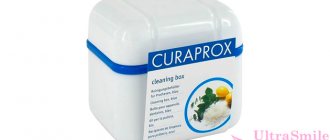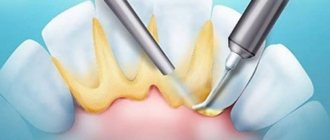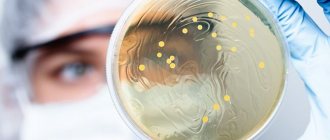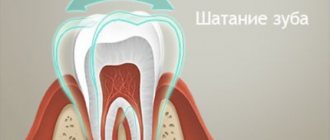From this article you will learn:
- what to do if the gum around the tooth is inflamed,
- what are the causes of inflammation,
- Medicines for gum inflammation are fast-acting and inexpensive.
The article was written by a dentist with more than 19 years of experience.
Depending on the cause of its occurrence, gum inflammation can be observed either in the area of most teeth (which is typical for gingivitis and chronic generalized periodontitis), or there can be a local inflammatory process developing in the area of just 1-2 teeth. The latter is typical for localized periodontitis, as well as for purulent periodontitis of the tooth.
How to treat gum inflammation (including medications) will depend on the cause of the inflammation, as well as the severity of the inflammatory process. If we are talking about gum inflammation due to gingivitis or periodontitis, in this case treatment will consist of anti-inflammatory therapy (antiseptic rinses, gel applications on the gums, sometimes antibiotics), as well as procedures for removing supragingival and subgingival dental plaque.
Inflammation of the gums: photo of catarrhal gingivitis
A completely different treatment is required if the inflammation of the gums near the tooth is local in nature (in the area of only 1-2 teeth). The causes of such inflammation can be - 1) overhanging edge of the filling and crown, injuring the gingival margin, 2) traumatic supercontacts between the upper and lower teeth, 3) inflammation at the apex of the tooth root. Therefore, if the gums near the tooth become inflamed, what to do in such situations is always to eliminate the specific causative factor that caused the inflammation. But drug treatment with drugs will not play a very big role in these cases.
The author of this article worked as a periodontist for more than 10 years, treating gum disease in patients, and therefore our recommendations really work (state-issued documents on advanced training in the Periodontology program can be seen in the editorial section). Below we will talk about inexpensive and effective drugs for the treatment of gum inflammation.
Why do gums become inflamed?
Before you think about how to relieve gum inflammation, you need to understand the cause of the problem.
6 common factors that provoke inflammation:
- Mechanical damage during dental care. People brush their teeth incorrectly and use mouthwashes that are not suitable for them. Sometimes the inflammatory process is also provoked by the use of dental floss, when it goes too deep and begins to cut the gums.
- Deposits on enamel. They appear due to improper oral hygiene, when a lot of plaque remains on the teeth. Often the problem is caused by a gradual build-up of tartar.
- Problems with wisdom teeth. When third molars begin to emerge, dental patients often experience discomfort and pain. The gums at the location of the tooth begin to become inflamed, and the process gradually spreads further.
- Dental diseases. Often inflammation becomes the first sign of pulpitis or caries.
- Incorrectly performed dental procedures. The problem manifests itself if the doctor committed violations in compliance with sanitary standards or violated disinfection technology during treatment, removal, prosthetics, or implantation.
- Complicated recovery period after surgery. Even if everything was carried out in accordance with the rules, there is a risk of complications from the human body. And such complications manifest themselves precisely in the inflammatory process. When it occurs, you need to quickly consult your doctor.
Also, do not forget about proper oral hygiene. The activity of bacteria and insufficient attention to brushing your teeth lead to inflamed gums.
Knowing the first of the above reasons, it is worth remembering to maintain balance and proper cleaning. It's best to consult with your dentist about which brush, toothpaste, and mouthwash are right for you.
To prevent this problem from occurring, it is important to undergo treatment only from an experienced dentist. Then reasons such as improper cleaning of canals or filling, or violation of sanitary standards in the workplace will be excluded.
We should also not forget that systemic damage to the body is also provoked by problems with the gums.
Diabetes mellitus is one of the most common provoking diseases. Gums become inflamed with reduced immunity, taking a number of medications, hormonal imbalance, and gastrointestinal lesions.
Therefore, the dentist often gives recommendations on visiting doctors of other specialties.
Causes of periodontal disease
The main cause of periodontal disease is insufficient blood supply to periodontal tissues, which in advanced cases leads to their atrophy. Experts are inclined to believe that hereditary predisposition plays a significant role in this case.
Periodontal disease in most cases occurs in adults, already at an older age, and is accompanied by systemic diseases - cardiovascular pathologies, diabetes mellitus, endocrine diseases, and pathologies of the gastrointestinal tract.
If a person is predisposed to periodontal disease, smoking acts as a negative factor - nicotine binds oxygen and complicates its “delivery” to all tissues, including periodontium.
In old age, one of the causes of the disease can be hypovitaminosis, especially against the background of natural weakening of periodontal tissue. Malocclusion and abnormal tooth position also contribute to the development of the disease.
How does gum inflammation manifest?
The process has three characteristics:
- The gums are swelling.
- Pain appears.
- The inflamed area feels warmer than neighboring areas.
Other symptoms depend on the cause provoking the phenomenon.
Common additional symptoms include:
- Bleeding when brushing teeth, metallic taste in the mouth.
- Separation of pus.
- Increased body temperature in the patient.
- Severe sensitivity of the teeth near the affected area to hot, cold and sour.
- Loosening of the tooth.
- Noticeable bad breath.
- Formation of white plaque on the gums.
Symptoms occur on their own or when eating or brushing your teeth. The gums on both the upper and lower jaws are susceptible to inflammation.
At the first signs, you should see a dentist as quickly as possible - the problem can progress and lead to tooth loss.
You can recognize the process at home. The affected areas turn red and a white coating appears on them. At the same time, there are complaints about the listed symptoms.
Which doctor treats periodontal disease and periodontitis?
Periodontal disease and periodontitis are treated by a periodontist. The focus is on restoring the gingival junction and increasing blood circulation. When prescribing treatment, the doctor must take into account the individual characteristics of the patient, his age and the presence of systemic diseases.
Even if your teeth have started to become loose, this does not mean that they will definitely have to be removed. The doctor will try to preserve them in any case. If necessary, fixation of mobile teeth is carried out by screw splinting or splinting with flex arcs.
Types of inflammatory diseases
There are two categories of diseases that provoke the development of such a process. These include:
- Diseases affecting soft tissues. They are caused by injury to the gums. It occurs due to mechanical pressure and chemical burns.
- Diseases of the mucous membrane. Most often they are provoked by infection or fungi. These include diseases such as stomatitis, gingivitis, periostitis, and periodontitis.
Only a doctor can tell you the exact reason. A visual examination of the oral cavity is carried out, and tests for various pathogens will also be required.
Physiotherapy
One of the most effective methods of relieving symptoms is physical therapy. The procedures promote the flow of oxygen to periodontal tissues and improve their blood circulation. As a result, increased tooth sensitivity is eliminated and atrophy processes are slowed down.
The following physiotherapeutic techniques are recommended for the treatment of periodontal disease:
- D'arsonvalization
- indicated after professional cleaning, carried out with a special device that generates high-frequency alternating current. The procedures help reduce pain and significantly improve blood circulation. - Laser therapy
- promotes tissue regeneration, relieves swelling and inflammation, and eliminates infections in periodontal pockets. It is not used as an independent method of treatment, only in combination. - Vacuum therapy
- acts directly on the capillaries of the periodontium, stimulates the nutrition of the gums and bone tissue. - Electrophoresis (with calcium gluconate)
- is prescribed mainly to relieve pain when the necks of teeth are exposed.
Another method of physiotherapy is treatment with negatively ionized air, which promotes the expansion of capillaries in periodontal tissues.
How to quickly relieve gum inflammation
Different approaches are used to combat this disease. It is important to eliminate the original problem, then relieve the symptoms and take care of prevention so that the inflammation does not return again.
Let's consider proven areas of treatment.
Gels, solutions and ointments
The principle of use is application to the gum surface. A gentle and gentle rubbing is required.
Among the most effective drugs:
- Holisal . Apply to inflamed areas twice a day. The course of treatment is from 7 to 10 days. The product has a mild soothing effect and quickly relieves swelling from the affected area.
- Periodonticide . The principle and duration of administration are the same as for Cholisal. The composition is effective due to the large number of essential oils in the composition.
- Metrogil denta . Fights germs. Used with the same frequency as the two drugs above.
- Heparin ointment . Twice a day, gently rub into the gums. Relieves swelling, kills germs, soothes tissue and reduces pain.
- Traumeel S. Used as an application for four weeks. A natural drug with a pronounced effect.
The patient always has a question - what to choose, ointment or gel. Ointments are less absorbed, but give a better effect.
The gel is easier to use, but it will take longer to apply. The level of effectiveness differs depending on the characteristics of the human body and the course of the disease.
Traditional medicine
Despite the fact that many are skeptical about traditional medicine, the components used have a pronounced calming, antiseptic and anesthetic effect.
The same calendula extracts are actively used in ointments and gels, so why not use the plant directly.
The main thing is not to self-medicate until the doctor has approved the remedies you have chosen and has determined the cause of the problem.
3 proven products:
- Chamomile solution. Used for rinsing. You need to buy dried flowers of the plant, pour a glass of water over them and boil for at least 10 minutes. After straining, rinse your mouth up to three times a day.
- St. John's wort solution. You will need two tablespoons of dry plant. They are poured with two glasses of already heated water and boiled for 10 minutes. The frequency of rinsing is the same as for chamomile.
- Aloe. Apply a paste of plant leaves wrapped in a sterile bandage to the site of inflammation twice a day.
The classic solution of soda and salt also works well.
Special toothpastes
Your doctor may advise you to use specially selected toothpastes that contain a high percentage of beneficial plant components, as well as chlorhexidine, bisabol, and allantoin.
Among the most common recommendations are pastes such as Lacalut active, Parodontax, President Exclusive.
They have a pronounced antiseptic effect, help get rid of germs, soothe gums and significantly reduce inflammation.
It is important to remember that such products are used for a limited time - usually up to two weeks. After this, you should stop taking it.
Rinse
There are also several special solutions that doctors recommend rinsing your gums on a set schedule.
These include:
- Chlorhexidine. Copes with bacteria. The frequency of rinsing is up to 4-6 times a day.
- Furacilin. You will have to prepare the solution yourself. To do this, it will be enough to simply dissolve one tablet in 200 ml of water. The frequency of rinsing per day is 2-3 times.
- Rotokan. An important feature of this product is that it contains many natural ingredients that perfectly relieve inflammation. You will need to rinse your mouth up to three times a day. In this case, it is enough to simply dilute a tablespoon of Rotokan concentrate in a glass.
You can also use Stomatofit. Add two tablespoons to 50 ml of water.
As with all other remedies, you should not self-medicate - all rinses are performed only in consultation with your doctor.
Other treatments
Depending on the patient’s condition, dentists may recommend other remedies to relieve gum inflammation.
These include the following methods:
- Massage. It is carried out at home to reduce inflammation and restore normal blood circulation in the gum area. Massage can be carried out either with your fingers or using special brushes recommended by the dentist.
- Taking vitamins. The three most popular types of vitamins are A, PP and D. The patient may also need to consume complexes with a high content of calcium and phosphorus.
- Drug treatment. It is used only on the recommendation of a doctor - he prescribes the necessary medications. These include such as Flemoclav, Metronidazole, Ciprofloxocin and others.
In the most complex and advanced cases, surgical treatment is used. There are several options for work - open curettage method, patch surgery, excision of the hood.
In order not to end up with surgery, you need to be attentive to your body and promptly contact your dentist at the first sign of problems with your gums.
Drug treatment
After removing dental plaque (this procedure is mandatory to exclude possible infection), the doctor prescribes general and local therapy. The patient is prescribed, depending on his condition and stage of the disease, immunomodulators, antibiotics (if necessary), and vitamin preparations. Medicines are selected individually, and if necessary, consultations with the attending physician on the underlying disease are prescribed.
In the acute stage of the disease and with pronounced atrophy of the periodontal tissue, the doctor prescribes targeted antibiotics - metronidazole or doxycycline. Treatment time and dosage are also determined only by the doctor.
The doctor may recommend a diet that will help compensate for the lack of vitamins of a particular group (in addition to vitamin complexes).
As local therapy, antiseptic treatment of the oral cavity is prescribed, including rubbing ointments and rinsing, as well as injections into the gums.
Where can I buy
Traditional herbal medicine puts forward high quality medicinal raw materials as the main requirement for independent production of medicines. High-quality folk remedies in finished form, as well as ingredients for their preparation, are offered by the Russian Roots online store. Delivery of ordered goods in Moscow and the Moscow region is carried out by couriers, and in other regions by mail. You can also purchase the required product in our herbal pharmacies in Moscow.
Attention! All materials published on our website are protected by copyright. When re-publishing, attribution and a link to the original source are required.
Vitamins and diet for periodontal disease
When treating periodontal disease, it is necessary to follow a diet. Proper (read: rationally composed) nutrition will restore the balance of vitamins and microelements, without which recovery will become impossible.
Products that should be on your table:
- cheeses, cottage cheese, milk, kefir - as the main source of calcium;
- liver, raw and boiled carrots, pumpkin – a source of vitamin A;
- legumes, oatmeal, buckwheat, parsley, egg yolk, fatty fish - B vitamins;
- red berries, red peppers – contain vitamin P;
- citrus fruits, sauerkraut, cranberries, lingonberries, currants - contain vitamin C.
Exclude from the diet:
- strong black tea and coffee;
- carbonated drinks;
- cookies and other flour products that stick to the teeth.
Pay special attention to sugar and sweets. If you cannot do without them, you should definitely rinse your mouth after eating, since sugar promotes the proliferation of pathogenic microflora in the oral cavity.
Intervention by a surgeon or orthopedist
At an advanced stage of the disease, drastic measures are inevitable. In cases where drug and physiotherapeutic treatment no longer produce results, and degenerative processes continue to progress, the help of a surgeon and orthopedist is necessary.
The doctor removes the most problematic teeth and cleans out periodontal pockets. After this, the orthopedist begins work. In place of the removed teeth, prostheses are installed - metal-ceramic bridges or complete dentures. In case of fan-shaped divergence of teeth, splinting dowels are used to fix the teeth in the affected area.










